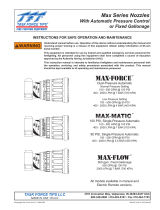
©Copyright Task Force Tips LLC 2002-2023 8 LIX-630 July 13, 2023 Rev22
4.2 SAFETY SHUT-OFF VALVE OPERATION
The BLITZFIRE is equipped with a Safety Shut-Off Valve. The Safety Shut-Off Valve will shut off the flow to the monitor if the monitor
starts to move. The Safety Shut-Off Valve relies on acceleration of the BLITZFIRE as the signal to activate. It activates at approximately
one G of sideways acceleration. Placing the BLITZFIRE on tilted surfaces (greater than 10 degrees) may inhibit the resetting of the
Safety Shut-Off Valve. The hose connected to the BLITZFIRE should contain any forward or backwards motion to safe levels.
Safety Shut-Off Valve operation:
1. Set up the monitor and charge the hose.
2. Point the nozzle in the desired direction.
3. Open the valve by pulling the locking pin and pulling back on the halve handle.
4. Place the handle in the desired detent position (further back for more flow, further forward for less).
5. If the monitor starts to slide, the safety valve will sense the movement and release the valve.
- An internal spring and water pressure will move the valve handle forward to the closed position and shut off the water flow.
- The valve handle will lock in the closed position.
6. After the cause of the sliding has been corrected, assure the valve is fully closed and reopen the valve as described in Step 3.
If the Safety Shut-Off Valve fails to reset, the valve will not remain open. Failure to reset may be due to placing the monitor on an
excessively sloped surface.
The Safety Shut-Off Valve is set at the factory to completely shut off the flow when tripped. To change the shut-off to reduce the flow
rather than perform a complete shut off, see the enclosed card, “Instructions to Maintain Minimal Water Flow When the Safety Shut-Off
Activates” (LIX-640), or contact customer service at tft.com.
4.2.1 SAFETY SHUT-OFF VALVE TEST
With hose uncharged and BLITZFIRE on a level surface:
1. Open the Valve Handle to the fully open position.
2. Grasp the monitor and give it a sideways jerk, rotate the monitor sideways, or hit the monitor on the side with a rubber mallet.
3. Safety valve proper function is indicated by the valve handle moving toward the closed position. NOTE - With water flowing, the
valve has additional forces on it that will move the valve to the fully closed position.
If the Safety Shut-Off Valve fails this test, return the monitor to Task Force Tips to restore proper functioning of the valve. Using the
monitor without a properly functioning Safety Shut-Off valve is a misuse of the product.
4.2.2 MANUAL OVERRIDE OF SAFETY SHUT-OFF VALVE
On sloping terrain it may be necessary to manually override the Safety Shut-Off Valve. The Safety Shut-Off Valve can be overridden by
the operator manually holding the valve handle in an open position.
The Safety Shut-Off Valve requires approximately one G of sideways acceleration to activate.
Forward and backward movement alone will not activate the Safety Shut-Off Valve. At low
accelerations, the monitor may travel several yards (meters) and gain enough velocity to cause
injury before the safety shutoff activates.
To reduce the risk of unlimited movement:
• Always keep the hose directly behind the monitor.
• Never loop the hose in front of the monitor.
• Always tie the monitor off securely.
To reduce the risk of personal injury from a moving/sliding monitor:
• Keep personnel out of the potential path of a moving/sliding monitor.
Improper repairs may result in a malfunctioning Safety Shut-Off Valve, which could result in serious
injury or death. Always return the monitor to Task Force Tips for any repairs to the safety shut-off
valve.
Valve must be fully closed to reset the safety shut-off valve mechanism. Once tripped, the valve
handle will not stay open unless the mechanism is reset by fully closing the valve.
The Safety Shut-Off Valve is intended to shut off the monitor when it detects sudden sideways
movement. It cannot prevent movement, but is intended to limit motion. To reduce the risk of severe
injury or death:
• Test the safety shut-off operation before each use.
• Always use adequate means to secure the monitor to reduce movement.
Overriding the Safety Shut-Off Valve requires the monitor to be manned. Tampering with the valve
handle will render the Safety Shut-Off Valve inoperable and could result in injury or death. Never tie
or prop open the valve handle.





















